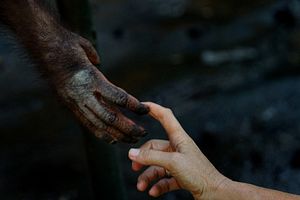The iconic orangutan prints on the green 500 rupiah bills in Indonesia are forever etched in my memory. During my childhood, we used the bills to joke with friends, comparing them with the picture of the primate. It was only later that I came to see the great apes as something more — symbols of the urgent need to preserve both the orangutan species and the forests where they live; natural shelters of biodiversity.
This photo essay aims to display daily life inside the Orangutan Conservation Center. Here, the relationship between orangutans and the keepers varies. At times, it is much akin to surrogacy; at other times, it is more like the bond between sheep and shepherds. Consisting mostly of young enthusiasts, the keepers venture deep into the forest every day. This is the “forest school,” where they prepare the big bipedal red-furred primates for their release into a natural habitat. The keepers follow the orangutans, monitoring and checking on them.
The keepers know full well that this job is not risk-free. Dealing with orangutans being prepared for the wildlife requires alertness and knowledge. What they do is both an adventure and a rare life experience.
Orangutans are not only intelligent, but also acutely observant. According to evolutionary anthropology expert Raffaella Commitante, humans and orangutans share many similarities — including 96.4 percent of their DNA. Among the many resemblances, Commitante highlights how humans and orangutans think and process information similarly.
This once mighty ape is known to have traveled across south China and Java Island during the Pleistocene era, approximately 10.000 years ago. But now, the species lies on the brink of extinction. These melancholy-looking animals are treated as pests and nuisances by plantation companies. Corporations consider them to be trespassers and fruit thieves. To make things worse, orangutans are hunted for their skulls and organs, which can be sold on the black market for a high price.
Sadly, orangutans have been railroaded for the past 75 years. Their tropical rainforest habitat in Indonesia has diminished by approximately 80 percent. Despite the hunting, deforestation is their biggest threat. The orangutans’ habitat decreases whenever rainforests are turned into plantations and mines. Sporadic illegal logging is another problem that speeds up the process. As a result, the orangutan population has drastically declined and the International Union for the Conservation of Nature (IUCN) has declared the species to be “Critically Endangered.”
The Dayak Wehea tribe in East Kalimantan believes orangutans to be the incarnation of man. To kill or, even worse, to prey on orangutans will result in curses and catastrophes. With the species teetering on the edge of extinction, it is time for us to decide if we are willing to act to prevent that curse from falling on our collective heads.
Adzwari Ridzki is a photographer from Indonesia, currently working at an international NGO focused on animal welfare.















































